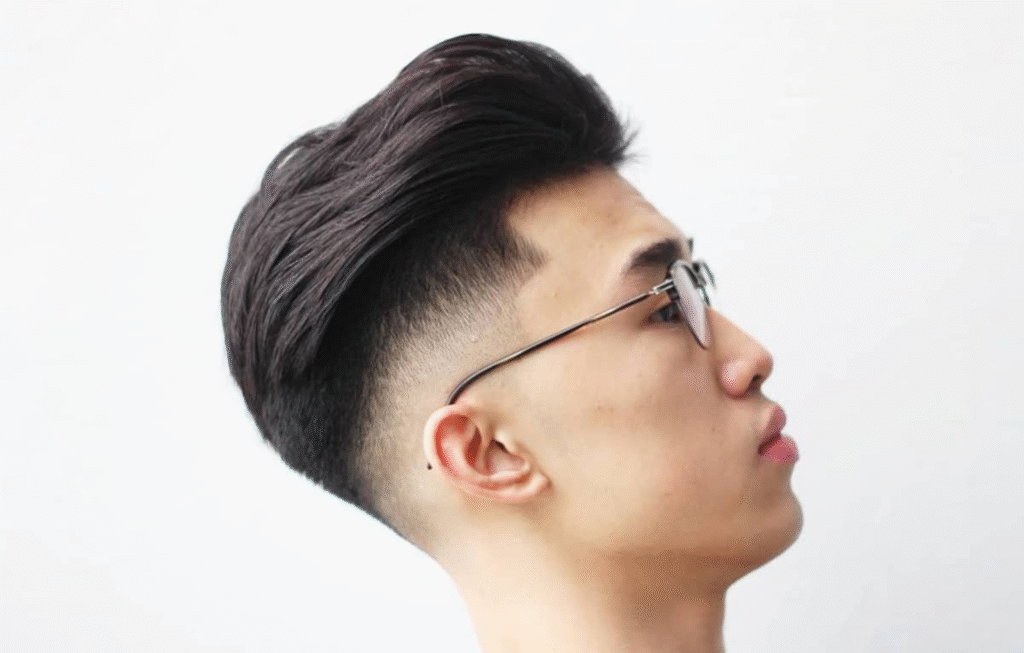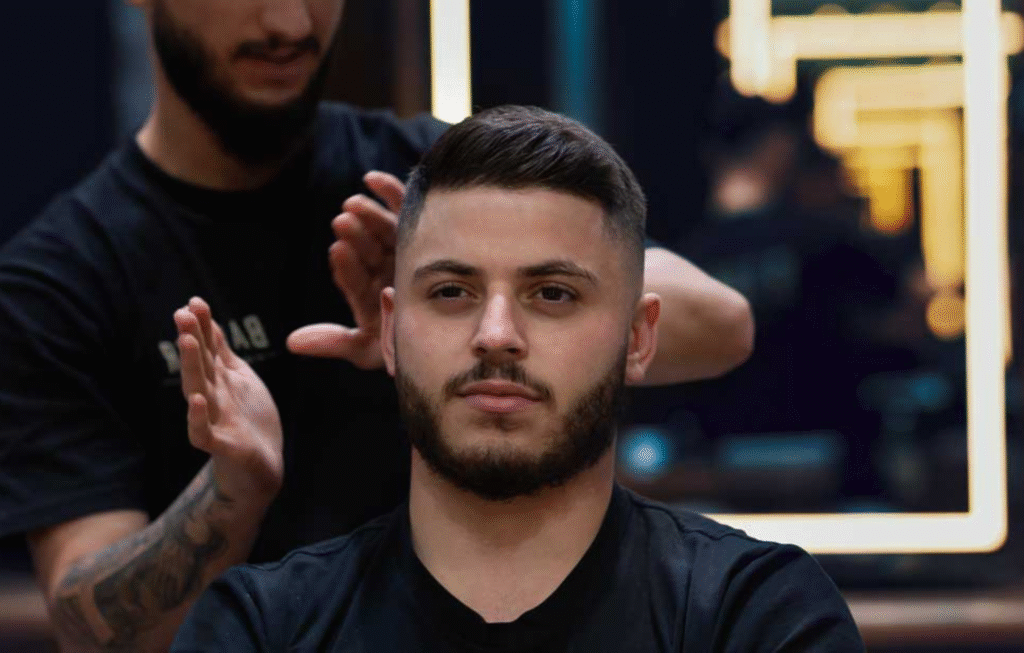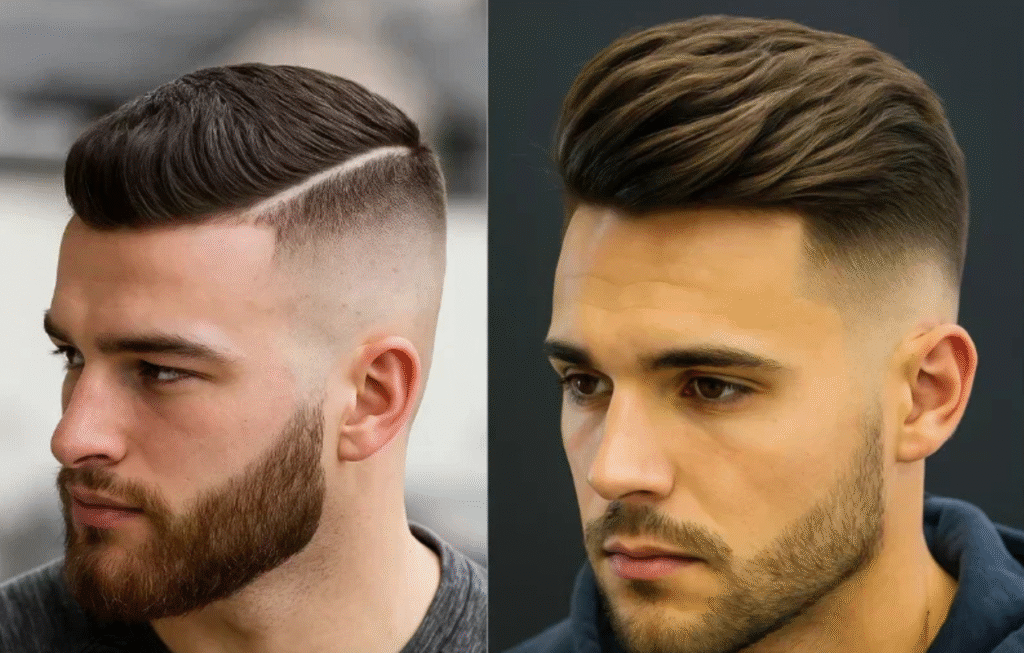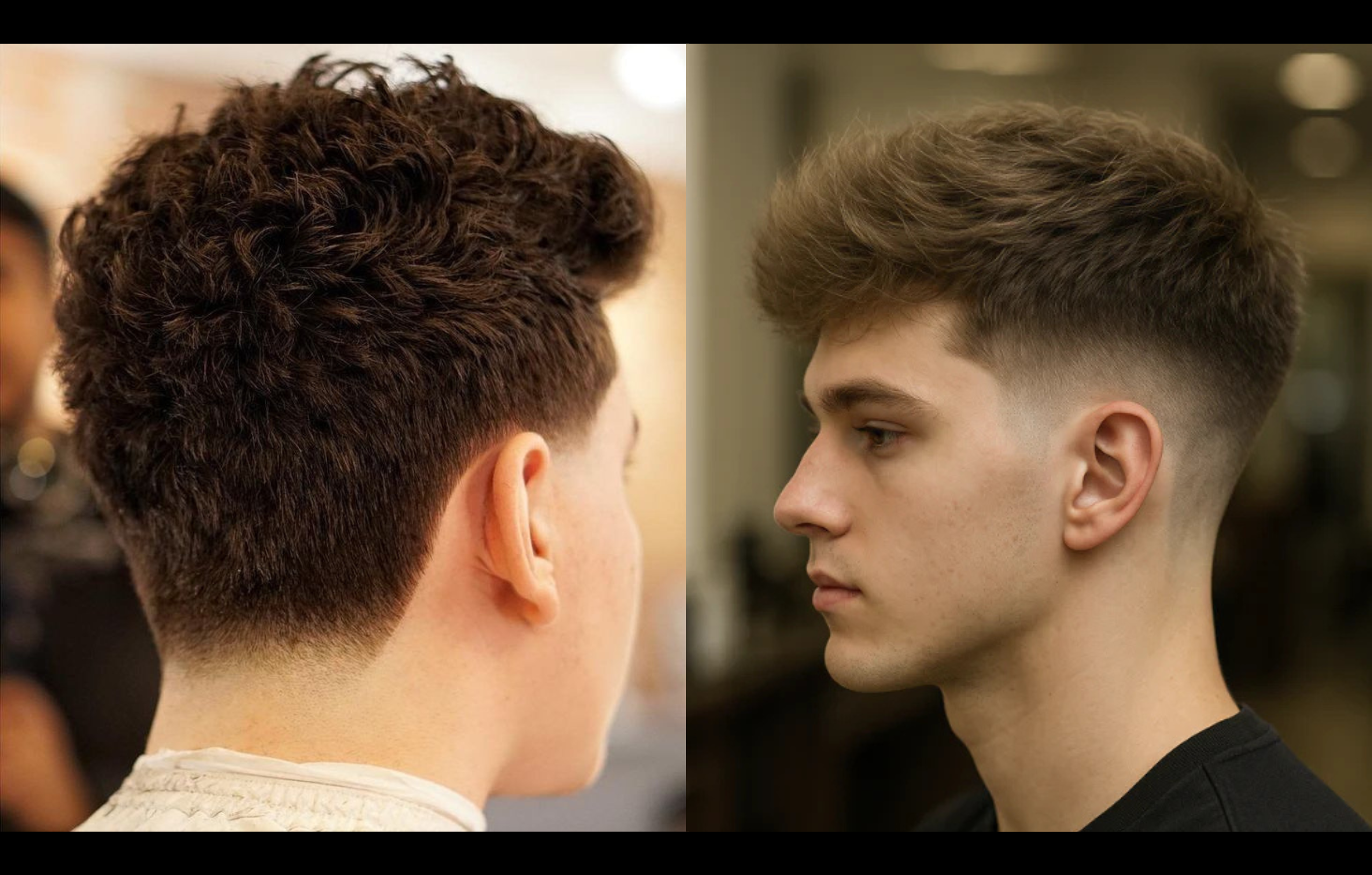What is Fade and Taper?
Before choosing a haircut, one must know the difference between “fade” and “lose” as people usually use the two terms interchangeably.
What is a Taper?
A taper is a haircut wherein the hair slowly reduces in period from the top to the back and sides. But take observe that there are nonetheless hairs on the lower back and sides, without exposing any seen scalp.
Key points:
- The length change is subtle and smooth.
- The hair is typically not cut to the skin.
- It tends to be classic, professional, and low-contrast.
- Such as: low taper, mid taper, high taper.
What is a Fade?

A fade is a “dramatic” variant of the taper: sides and back are shaved very closely or to the skin, with a strong contrast between top and sides.
Key points:
- Top hair is left long, with sides and back very short or shaved to the skin—greater contrast.
- It requires a bit more maintenance since the gradient is sharp.
- Variations galore: low fade, mid fade, high fade, skin fade, drop fade, burst fade, temple fade, etc.
In plain words:
- Taper = gradual reduction, hair on the sides and back stays, less contrast.
- Fade = drastic cut, sides and back are extremely short/to the skin, more contrast, a sharper image.
A barber put it wonderfully: “Taper is like a dimmer switch; Fade is like an on-off switch.”
Why This Gap Matters in 2025
Guys’ haircuts in 2025 aren’t loads approximately “traits,” but about your manner of life, your face shape, how frequent you go to the barber, and your hair kind.
Some quick points:
- Fades remain extremely popular—but they’ve gotten way more creative (such as bursts or drop fades).
- There’s also an increase in individuals seeking styles that need fewer barber appointments and are simpler to maintain—so demand for tapers is also on the rise.
- Texture of hair (wavy, curly, natural texture) is also extremely important these days—styling the sides-back can make the overall appearance completely different.
- Professional settings are nevertheless taken into consideration—so a taper with extraordinarily excessive comparison (e.G., a really glamorous pores and skin fade) may not be appropriate anywhere; a taper is probably extra appropriate in those places.
So, determining between a fade and a taper isn’t always genuinely approximately “what looks better,” however approximately what fits you higher—thinking about your hair, face, way of life, and preservation abilties.
Fade vs Taper — A Comparison
| Features | Taper | Fade |
|---|---|---|
| Contrast (top vs sides) | Low to medium | Medium to very high |
| Shortest length on sides and back | Some hair still left (no skin visible) | Can reach skin or have very short hair left |
| Gradation / Blend | Smooth and light | Sharp and sharp |
| Maintenance frequency | Low — Can last 3-4 weeks or more | High — Will need a barber visit every 1-2 or 2-3 weeks |
| Look / Fitness | Classic, Professional, Cool-Style | Modern, Edgy, Fashion-Forward |
| What Hair Types/Uses | Suitable for Most; If the Sides-Backs Don’t Want Them Too Short | Best When the Sides-Backs Are Very Short and Accentuate the Top |
| Variations/Customization | Low Taper, Mid Taper, High Taper | Low Fade, Mid Fade, High Fade, Skin Fade, Drop, Burst, etc. |
What Should You Choose for Yourself?

Consider Your Face Shape
- If you have a round face → A bit of height on top and more defined sides will lengthen your face — a fade can benefit here.
- If you have an oval or square face → Both can work; a taper can provide a balanced, classic look.
- If you have a long face → A very high fade will lengthen it; A low taper or low fade would be more suited for this.
Check Hair Type/Texture
- Straight hair → Tapers and fades each paintings; a fade can be used to add definition to the edges.
- Wavy or curly hair → It is easier to keep the natural texture of the returned and aspects with a taper; going with a fade will make the edges and lower back very brief, which could take some being used to for humans who’ve curls.
- Very thick hair → A fade will thin out the sides and back; a taper produces openness.
- Thin hair → A fade will leave the back and sides very short, with the top being the focus; a taper will have some hair remaining on the sides and back, which can be an excellent means of keeping the sides and back straight. Maintains balance.
Prepare Lifestyle & Maintenance
- If you do not desire to go to the barber too frequently, a taper is more sensible.
- If you want to style, visit the barber every week, and desire a easy look, you could choose a fade.
- Think about your workplace: If it’s an office or formal party, low taper or low fade is a more suitable option. If you’re in a design industry or have a style sense, you can opt for a mid/high fade.
- Think about sideburn/neck growth: If you don’t feel like performing every day grooming, a taper is a sure choice.
Think about how long the hair on the top is
- If the top is extremely short (buzz cut, crew cut) → a fade would look amazing because the sides will be extremely short and add contrast.
- If the top is slightly longer (pompadour, side part, textured crop) → A taper is a good choice since having a small amount of hair on the sides-back balances the style.
One source reported: “Classic gentleman styles work best with a taper-fade, while a full fade transition is suitable for modern, aged hairstyles.”
Popular Variants & Their Uses in 2025
Fade Variants
- Low Fade: Begins higher up around the ears/nape; low contrast; suitable for professional environments.
- Mid Fade: Begins about the temples; medium contrast.
- High Fade/Skin Fade: Sides-returned very near the pores and skin, regularly to the skin; very high comparison; excessive upkeep.
- Drop Fade / Burst Fade / Temple Fade: The fade is lightly curved like a “drop” or “burst” across the ears and returned; a contemporary fashion.
Taper Variants
- Low Taper: Contemporary but relaxed; begins above the ears; clean and simple.
- Mid Taper: Just around the temples; a clean-cut look.
- High Taper: Begins slightly higher; provides a bit more openness but not as much as with a skin fade.
“Taper-Fade” (Hybrid)
Most barbers seek advice from it as “taper-fade” because it’s a mixture of the 2—a taper but with a fade-kind transition, or a fade but the sides-lower back are not absolutely skin-on. So ensure you’re express approximately what you’re looking for whilst you communicate along with your barber.
How to Communicate with the Barber & What to Bring

- Bring pictures: This is the simplest way to flaunt what you desire.
- Say: “I want [the style length] on top + a [fade/taper] on the sides/back, beginning”
- For a taper, say: “There should be some hair left on the sides and back, no skin visible, and the hair should decrease gradually.”
- For a fade, say: “Sides and back should be nearly skin-length or very short, with a high contrast to the top.”
- Talk about the neckline, sideburn length, and the sharpness of the edges.
Tips on Maintenance and Styling
Taper
- Since the transition is not as abrupt, you can skip barber visits for roughly 3-4 weeks or even longer.
- As the hair grows out, the style doesn’t seem as “horrible” since there is less contrast.
- Styling: Use product (texture paste, wax, etc.) depending on the length of the hair.
- Neaten the sideburns/neckline.
Fade
- With the high contrast, the hair can become “messy” very easily as it grows out; you might need to see the barber after 1-2 weeks or 2-3 weeks.
- Styling: Extremely brief sides and again make the pinnacle greater appealing—so the pinnacle style ought to be nicely styled.
- If you’ve got a skin fade, cope with the scalp and defend your pores and skin from the solar.
- If you have sideburns or a beard, fade them properly to decorate the style.
Pros-Cons
Taper
Advantages:
- Neater-looking even when growing out.
- Low maintenance.
- Can work in most environments (office, relaxed).
- Easier to maintain longer on top.
Disadvantages:
- Less contrast—if you prefer a very “crisp” appearance, the taper will fall short.
- Those who prefer to look aged will find it a bit bland.
Fade
Advantages:
- Produces a very contemporary, edgy, and stylish appearance.
- Emphasizes the hair on the top.
- A wide range of innovative choices to choose from.
Drawbacks:
- More maintenance.
- As hair grows, the style can soon become “unclear.”
- If your workplace is extremely formal, a very high fade might be overkill in some environments.
Real-Life Examples and When to Opt for Which One
- If you are a company expert type (office, formal garments, daily conferences) and need a fashion-ahead however now not too attention-in search of reduce, choose a low taper or low fade.
- If you figure within the innovative subject, are a scholar, or possess a experience of fashion and appreciate barber visits, a mid or high fade (skin fade or drop fade) may be more appropriate.
- If your hair is textured/curly and you’re looking to keep the herbal texture on the sides and lower back, a taper ought to work.
- If your hair is very thick and you would like to skinny out the edges and lower back and emphasize the length in the top place, a fade might be useful.
- If you’re letting your top grow out (mid-length) — a mix of the sides and back is necessary; a rapid fade will have an awkward appearance as it grows out — thus, a taper could be more suitable.
- If you reside in a hot/humid climate and prefer keeping your sides and back extremely short for comfort — a fade (low or mid) is a great choice.
2025 Trend Updates
- Fades are getting more creative — styles such as the drop fade, burst fade, and temple fade are all popular.
- Certain market studies indicate that extreme fadesDemand for skin-fades is dwindling somewhat because individuals prefer to cut back barber cleanups; because of this, taper or low-fade are gaining popularity.
- Texture and natural hair are becoming more significant—so the cut on the sides and back has a big impact on the overall style.
- Most haircuts feature a fade/taper on the sides and back with texture or some length on top—so the “sides and back” treatment is just one element of the overall style.
Conclusion
Selecting a fade versus a taper isn’t about “which is more attractive”—it should be about whether the haircut is appropriate for you—considering your hair texture, face shape, style habits, and personal lifestyle.
Simply put:
- If you desire a crisp, graphic, high-contrast appearance, and don’t mind a visit to the barber, go with a fade.
- If you desire a relaxed, timeless, low-fuss appearance, go with a taper.
When you go to the barber: deliver a photograph, pick out the top style, kingdom how short you’d just like the sides and back, and inquire approximately how often you want to move in to have it finished. State whether or not or now not you want to have a cut right up to the pores and skin (fade) or to have hair on the perimeters and lower back (taper).
And since 2025 hairstyles are all about harmonizing with your hair, not wrestling with it, whatever the cut you go for, ensure it’s simple to manage and comfortable. A good cut that suits you will always appear more attractive than a fashionable cut that doesn’t feel right to you.
FAQs
How’s a fade different from a taper haircut?
A taper reduces hair gradually without revealing skin. A fade shaves hair all the way to the skin, making the top and sides contrast more sharply for an edgier style.
Which haircut will last longer — taper or fade?
Tapers do not require maintenance for longer periods of time—typically 3–4 weeks. Fades require touch-ups every 1–2 weeks because the harsh line that grows out more gradually and rapidly.
Is a fade newer than a taper?
Yes, fades are a more modern and trendy look, commonly used in today’s style. Tapers provide a neater, traditional appearance better suited to formal or conservative settings.
